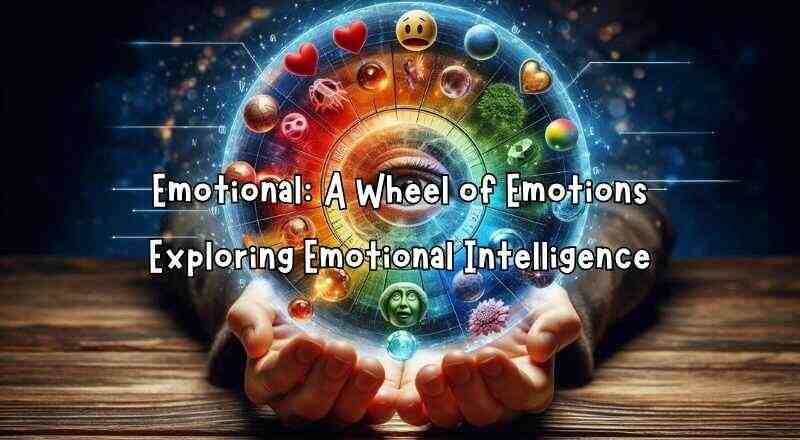Emotional intelligence, or EI/EQ, is the skill of recognising, understanding, managing, and using both personal emotions and the emotions of others. It goes beyond mere cognitive intelligence (IQ) and delves into the realm of interpersonal and intrapersonal skills. EI plays a crucial role in how we navigate social complexities, make decisions, and cope with challenges. It is not simply about being “nice” or “emotional”, but rather about having a keen awareness of feelings and their impact on behaviour. Its importance lies in its capacity to foster effective communication, build strong relationships, enhance problem-solving, and improve overall well-being. A high level of emotional intelligence can lead to greater personal fulfilment and professional success.
- Overview of the Wheel of Emotions
- Understanding Emotional Intelligence
- Benefits of High Emotional Intelligence
- Examining the Wheel of Emotions and Its Significance
- The Wheel of Emotions
- Secondary Emotions
- Using the Wheel of Emotions
- Developing Emotional Intelligence Skills
- Strategies for Self-Regulation
- Enhancing Empathy and Social Skills
- The Impact of Emotional Intelligence on Life
- Case Studies and Real-Life Examples
- Conclusion
Overview of the Wheel of Emotions
The Wheel of Emotions, developed by Robert Plutchik, serves as a valuable tool for visualizing and understanding the complex landscape of human emotions. This circular diagram categorizes emotions into primary emotions and their variations, offering a framework for mapping the intensity and interconnectedness of different feelings. Eight fundamental emotions—joy, trust, fear, surprise, sadness, disgust, and anticipation—serve as the basis for the wheel’s framework. Each of these primary emotions has varying degrees of intensity, moving from low to high. Additionally, adjacent emotions can combine to form more complex, blended emotions. The purpose of the Wheel of Emotions is to provide a visual and conceptual aid that facilitates a deeper understanding of emotional experiences, enabling individuals to identify, label, and articulate their feelings more accurately and effectively. By using the wheel, one can gain insights into emotional patterns, triggers, and responses, thereby enhancing self-awareness and emotional regulation.
Importance of Understanding Emotions

Understanding emotions is essential for attaining a healthy and fulfilling life. Emotional awareness acts as a foundation for mental health, interpersonal relationships, and effective communication. When individuals are attuned to their emotions, they are better equipped to manage stress, cope with adversity, and make informed decisions. Furthermore, emotional intelligence fosters empathy and compassion, allowing individuals to connect with others on a deeper level, build strong, supportive relationships, and navigate social situations with grace. In the realm of communication, an understanding of emotions enables individuals to express themselves clearly and respectfully while also being receptive to the feelings of others. It minimises misunderstandings, promotes collaborative problem-solving, and creates an environment of trust and mutual respect. The ability to recognise and understand emotions, both in oneself and in others, directly influences overall psychological well-being and social effectiveness, contributing to personal growth and a more harmonious existence.
Understanding Emotional Intelligence

The role of emotional intelligence (EI) in both personal and professional development. Emotional intelligence involves self-awareness and self-regulation, along with the capacity to perceive and positively impact the feelings of those around you. This section delves into the key components, benefits, and a useful tool for developing emotional intelligence.
Components of Emotional Intelligence
Emotional intelligence is not a single skill but rather a combination of several interconnected abilities. These fundamental components work together to create a holistic understanding and application of emotions.

Self-awareness: This is the foundation of emotional intelligence. It involves having a deep understanding of one’s own emotions, strengths, weaknesses, drives, values, and impact on others. Self-aware individuals recognise their feelings as they occur and understand how their emotions influence their behaviour. They are also aware of their strengths and limitations, possess a sense of self-confidence, and are receptive to constructive feedback.
Self-regulation: Having identified one’s emotions, the next step is to develop the skill of managing them proficiently. Self-regulation refers to the capacity to control or redirect disruptive impulses and moods. It involves thinking before acting, delaying gratification, and managing stress effectively. Adaptability, comfort with ambiguity, and integrity are qualities that define individuals with strong self-regulation. They remain composed, even when facing difficult circumstances.

Motivation: Emotional intelligence also includes being driven to achieve beyond expectations, not just for money or status, but for inner goals. Motivated individuals are passionate about their work, optimistic even in the face of failure, and committed to their goals. These individuals possess a robust ambition for success, actively seek out opportunities, and demonstrate perseverance despite obstacles. This intrinsic motivation is a key factor in sustained success and personal fulfilment.
Empathy: Empathy is the ability to understand and share the emotions of another individual. It involves considering other people’s feelings, especially when making decisions. Empathetic individuals are sensitive to others’ perspectives, actively listen to their concerns, and show genuine interest in their well-being. They are skilled at building and maintaining rapport, understanding group dynamics, and fostering positive relationships.

Social skills: Establishing networks and cultivating relationships are fundamental aspects of emotional intelligence. Individuals with strong social skills are adept at finding common ground and building rapport with others. They are effective communicators, skilled at leading teams, and adept at managing conflict. They are also collaborative, influential, and skilled at building consensus. These abilities are essential for navigating social complexities and building strong, supportive relationships.
Benefits of High Emotional Intelligence

Developing and honing emotional intelligence yields numerous personal and professional advantages, significantly enhancing various aspects of life.

Better relationships: People with high EI tend to form stronger and more fulfilling relationships. Their ability to understand and empathise with others fosters trust, improves communication, and strengthens bonds. This leads to healthier relationships, both personally and professionally. They can navigate conflicts more constructively, understand different perspectives, and build connections on a deeper level.
Enhanced communication skills: Emotional intelligence greatly enhances communication. Individuals with strong EI can articulate their thoughts and feelings clearly and effectively, while also actively listening to others. They are aware of their own and others’ nonverbal cues, which improves their ability to communicate accurately and sensitively. This leads to a clearer understanding and fewer misunderstandings in interactions.
 Improved mental health: Emotional intelligence is closely linked to better mental health. Effective emotional management leads to reduced stress, anxiety, and depression risk. Developing self-awareness allows individuals to recognise emotional triggers and devise effective coping strategies. Self-regulation enables them to handle stress and difficult emotions in healthier ways, contributing to overall psychological well-being.
Improved mental health: Emotional intelligence is closely linked to better mental health. Effective emotional management leads to reduced stress, anxiety, and depression risk. Developing self-awareness allows individuals to recognise emotional triggers and devise effective coping strategies. Self-regulation enables them to handle stress and difficult emotions in healthier ways, contributing to overall psychological well-being.
Career success: In the professional realm, emotional intelligence is a significant predictor of success. A high degree of emotional intelligence often correlates with success in leadership roles, collaborative environments, and customer interactions. They are better at managing conflicts, motivating others, and building productive relationships. Their communication skills, empathy, and social abilities are invaluable assets, leading to increased opportunities and career advancement.
Examining the Wheel of Emotions and Its Significance

The Wheel of Emotions, developed by psychologist Robert Plutchik, is a visual tool that aids in recognising and labelling emotions. It presents eight basic emotions in a circle, with variations of intensity and combinations of emotions branching out.
How the wheel aids in recognising and labelling emotions:
The wheel helps to distinguish between different emotions and their varying degrees of intensity. Consider “joy”, which spans from mere contentment to overwhelming ecstasy, or “fear”, ranging from simple apprehension to sheer terror. Conceptualising emotions along such a spectrum enhances self-awareness of one’s emotional condition and that of others. Furthermore, it facilitates the recognition of intricate emotions formed from blends of the eight fundamental ones. This enhanced emotional vocabulary and awareness are essential for effective communication, self-understanding, and building meaningful relationships. It is a valuable tool for those looking to improve their overall emotional intelligence.
The Wheel of Emotions
 Overview of the Wheel: The Wheel of Emotions is a visual representation designed to categorize and illustrate the spectrum of human emotions. An emotion wheel generally comprises a core that represents primary emotions, encircled by layers of secondary emotions arranged in concentric rings. This structure helps visualize the relationships between different emotions and how one can transition into another. The design often incorporates color to further distinguish emotional categories and intensities, making it a user-friendly tool for understanding emotional nuances.
Overview of the Wheel: The Wheel of Emotions is a visual representation designed to categorize and illustrate the spectrum of human emotions. An emotion wheel generally comprises a core that represents primary emotions, encircled by layers of secondary emotions arranged in concentric rings. This structure helps visualize the relationships between different emotions and how one can transition into another. The design often incorporates color to further distinguish emotional categories and intensities, making it a user-friendly tool for understanding emotional nuances.
Primary Emotions

Foundational elements of emotional experience are thought to be the primary emotions. They are generally universally recognized and often linked to basic survival instincts. The fundamental emotions in the Wheel of Emotions include:
- Fear: Fear is a response to perceived danger or threat, triggering the body’s fight-or-flight response. Apprehension can be minimal, while panic can escalate to intense levels. Examples include fear of heights, public speaking, or loss.
- Joy: Happiness and delight define joy. It represents contentment and satisfaction, frequently arising from positive experiences and accomplishments. Examples include the joy of receiving good news, spending time with loved ones, or accomplishing a goal.
- Anger: Anger, a powerful emotion that spans from mild irritation to extreme fury, stems from feelings of injustice, frustration, and perceived wrongs. Examples include anger at being unfairly treated, interrupted, or deceived.
- Sadness: Sadness is a feeling of sorrow and grief, often triggered by loss, disappointment, or misfortune. A spectrum of emotional states exists, encompassing subtle sadness to profound depression. Examples include sadness over the loss of a loved one, a failed relationship, or a missed opportunity.
- Disgust: Disgust is a strong feeling of revulsion and aversion, often related to things considered unpleasant or offensive. It can be physical, moral, or social. Examples include disgust at spoiled food, unethical behavior, or social injustice.
- Surprise: Surprise is a brief emotional state resulting from an unexpected event. Surprise can manifest as either a positive or negative emotion, contingent on the specific event that elicits it. Consider these instances: the joy of an unanticipated present, the startle of an abrupt, loud sound, or the appearance of an unplanned guest.
Each primary emotion is defined by its specific triggers, physiological responses, and behavioral expressions. Understanding these definitions and examples helps in recognizing and labeling emotions accurately.
Secondary Emotions

Primary emotions combine and interact to give rise to secondary emotions. They are more complex and nuanced, reflecting the multifaceted nature of emotional experience. Secondary emotions can be seen as variations or intensifications of primary emotions. For example:
- Fear can lead to anxiety, panic, or paranoia.
- Joy can lead to pride, elation, or contentment.
- Anger manifests as resentment, frustration, or intense fury.
- Sadness can lead to loneliness, grief, or despair.
- Disgust can lead to revulsion, contempt, or moral outrage.
The experience of surprise can evoke a range of emotions, including excitement, shock, and confusion.
By exploring how primary emotions lead to secondary emotions, the Wheel of Emotions allows for a deeper understanding of emotional depth and complexity.
Using the Wheel of Emotions

Emotional intelligence can be profoundly developed through utilizing the Wheel of Emotions, which serves as a valuable tool for understanding and regulating one’s emotions.. To utilize it effectively in daily life:
- Identify the Primary Emotion: Begin by recognizing the predominant emotion you are experiencing at this moment. Consider the fundamental emotions: fear, joy, anger, sadness, disgust, and surprise.
- Explore Secondary Emotions: To discover secondary emotions associated with a primary one, look at the wheel’s outer sections. Reflect on the subtleties and variations inherent in fundamental emotion.
- Understand Emotional Triggers: Consider what events or circumstances led to the feeling. This facilitates the identification of patterns and the comprehension of the root causes of emotional reactions.
- Practice Emotional Vocabulary: Using the wheel expands emotional vocabulary, enabling more precise and accurate identification and expression of feelings.
- Improve Emotional Regulation: Developing improved strategies for emotional management and regulation becomes possible when individuals comprehend the connections between emotions.
Through consistent practice, the Wheel of Emotions can become an indispensable tool for enhancing emotional intelligence and overall well-being.
Developing Emotional Intelligence Skills
 The cultivation of emotional intelligence is an essential component of both personal and professional development. It encompasses the ability to identify, comprehend, and regulate one’s own emotions, alongside the capacity to recognize, understand, and impact the emotions of others. Here are key strategies for developing emotional intelligence skills:
The cultivation of emotional intelligence is an essential component of both personal and professional development. It encompasses the ability to identify, comprehend, and regulate one’s own emotions, alongside the capacity to recognize, understand, and impact the emotions of others. Here are key strategies for developing emotional intelligence skills:
Self-Awareness Practices

Self-awareness is the foundation of emotional intelligence. It is the capacity to comprehend and assess your own emotions, strengths, weaknesses, motivations, values, and their influence on others. Enhancing self-awareness involves:
Journaling: Regularly writing down your thoughts and feelings can help you identify patterns, triggers, and emotional reactions. Reflect on specific situations, your responses, and the underlying emotions driving those responses. Evaluate the aspects that were and identify areas for improvement. This method promotes introspection and fosters a deeper comprehension of oneself.
Mindfulness and meditation: Practicing mindfulness involves paying attention to your present-moment experiences with openness and curiosity. Meditation helps to quiet the mind and increase awareness of thoughts and emotions without judgment. These methods improve your capacity to recognize your emotional states as they emerge, rather than allowing them to overpower you. This increased awareness allows for more thoughtful responses.
Emotional check-ins: Regularly taking a moment to assess your emotional state throughout the day can help you stay in tune with your feelings. Reflect on your current state by asking, “What emotions am I experiencing at this moment?” Identify the specific emotion (e.g., happy, frustrated, anxious) and consider what might be causing it. This practice helps maintain your connection to your emotional landscape.
Self-awareness is the foundation of emotional intelligence. It is the capacity to comprehend and assess your own emotions, strengths, weaknesses, motivations, values, and their influence on others. Enhancing self-awareness involves:
Strategies for Self-Regulation
 Self-regulation is the ability to manage and control one’s emotions and impulses. It allows you to handle challenging situations and emotions constructively. Effective strategies include:
Self-regulation is the ability to manage and control one’s emotions and impulses. It allows you to handle challenging situations and emotions constructively. Effective strategies include:
Coping mechanisms for managing intense emotions: Develop healthy ways to deal with strong emotions like anger, sadness, or fear. This might include activities like exercise, spending time in nature, listening to music, or talking to a trusted friend. Identifying and using these coping mechanisms helps prevent emotional outbursts and unhealthy reactions.
Techniques to delay reactions (e.g., pause, breathe): When faced with a stressful or emotionally charged situation, take a moment to pause and breathe. This enables you to refrain from impulsive reactions and respond more deliberately and thoughtfully. Counting to ten, taking deep breaths, or removing yourself from the situation temporarily can provide valuable time to regain control and perspective.
Enhancing Empathy and Social Skills

- Empathy: Empathy is the capacity to comprehend and share another individual’s emotions.. Social skills involve effectively managing interactions with others. These areas can be improved by:
- Active listening exercises: Practice giving your full attention to others, making eye contact, and asking clarifying questions. Reflect on what you’ve heard to ensure understanding. Truly listening without interrupting helps build connections and demonstrates genuine care.
- Role-playing scenarios to practice empathy: Engage in role-playing exercises to simulate real-life interactions and practice putting yourself in someone else’s shoes. This helps you understand different perspectives and develop more empathetic responses. Consider how others might feel in various situations and practice responding with kindness and understanding.
Setting Goals for Emotional Growth
 Setting clear and achievable goals can guide your journey to enhancing emotional intelligence. This involves:
Setting clear and achievable goals can guide your journey to enhancing emotional intelligence. This involves:
Creating actionable steps for improving emotional intelligence: Identify specific areas for improvement, such as managing anger or enhancing empathy. Divide your goals into smaller, more manageable tasks.. For example, if you want to improve active listening, set a goal to practice active listening in one conversation each day. Track your progress and celebrate your achievements. Consistent effort and focused attention will lead to significant emotional growth over time.
The Impact of Emotional Intelligence on Life

Emotional intelligence profoundly influences human existence, shaping personal interactions, professional dynamics, and overall well-being. Its significance cannot be overstated, as it equips individuals with the skills necessary to navigate complex social landscapes and manage their emotional states effectively.
Emotional Intelligence in Personal Life
Emotional intelligence is the cornerstone of healthy, fulfilling personal relationships. It enables individuals to understand and empathize with the feelings of others, fostering deep connections and trust.

Building and maintaining healthy relationships: By being attuned to their own emotions and those of others, individuals with high EI can communicate more effectively, resolve conflicts constructively, and offer support when needed. They are better equipped to build strong bonds with family, friends, and romantic partners, creating a network of meaningful relationships that enrich their lives. Empathetic response requires active listening, understanding nonverbal signals, and showing compassion.
Emotional Intelligence in the Workplace

In professional settings, emotional intelligence is a critical asset that drives productivity, collaboration, and leadership effectiveness.
Importance of EI in leadership and teamwork: Effective leaders who possess strong emotional intelligence (EI) can encourage and drive their teams by creating an optimistic and welcoming atmosphere. They are skilled at resolving conflicts, providing constructive feedback, and recognizing the contributions of others. In teamwork, EI promotes cooperation, mutual respect, and a shared sense of purpose, leading to enhanced performance and job satisfaction. Teams with members possessing high EI are more likely to be productive, innovative, and resilient.
Case Studies and Real-Life Examples
Real-life examples and case studies provide tangible evidence of the power of emotional intelligence in action.
Illustrating the relevance and impact of emotional intelligence through real-life scenarios: By examining specific instances where EI has made a difference, it becomes clear how these skills can lead to positive outcomes. From successful negotiations to conflict resolution in families, real-life scenarios demonstrate the practical value of understanding and managing emotions. Stories of individuals who have overcome challenges and achieved success through EI serve as inspiration and demonstrate the potential for personal and professional growth. Empathy, self-awareness, and social skills are frequently showcased in these instances, which illustrate their significant transformative impact.
Conclusion
Recap of Emotional Intelligence and the Wheel of Emotions

In summation, this exploration has underscored the critical role of emotional intelligence in navigating the complexities of human interaction and personal well-being. We have revisited the fundamental concepts of emotional intelligence, emphasizing its multifaceted nature that encompasses self-awareness, self-regulation, motivation, empathy, and social skills. Furthermore, we delved into the Wheel of Emotions, a valuable tool for identifying, labeling, and understanding the spectrum of human emotions. The Wheel serves as a visual aid, allowing individuals to pinpoint specific feelings, explore their intensity, and appreciate the interconnectedness of various emotional states. This comprehensive understanding of both emotional intelligence and the Wheel of Emotions provides a robust framework for enhanced emotional literacy and management.
Encouragement for Personal Development
We strongly encourage each reader to embark on a personal journey of emotional discovery and development. Utilize the insights derived from this discussion by actively incorporating them into your daily routine. Begin by analyzing your emotional responses and recognizing the factors that provoke them.. Consider how well you recognize and manage your emotions, and how effectively you empathize with and relate to others. The Wheel of Emotions can be an invaluable tool in this process. Use it as a guide to explore and label your feelings, gaining greater clarity and understanding. The pursuit of emotional intelligence is an ongoing journey, a process of self-discovery and personal development. Embrace this opportunity for growth, as the rewards—enhanced relationships, heightened awareness, and increased emotional resilience—are truly significant.
Call to Action
We invite you to continue deepening your understanding of emotional intelligence. To facilitate this ongoing learning, we recommend exploring the following resources: numerous books, online courses, and workshops dedicated to emotional intelligence are available. These resources delve deeper into theoretical frameworks, practical techniques, and real-world applications. Seeking out experienced coaches or therapists who specialize in emotional intelligence can also provide personalized guidance and support. Additionally, practicing self-reflection and journaling can be powerful tools for tracking your emotional patterns and progress. By taking these proactive steps, you can cultivate a rich and nuanced understanding of emotional intelligence and harness its power to transform your life positively.
visit our support page: Seasons Fruits: Amazing Nature Treats Each Season
